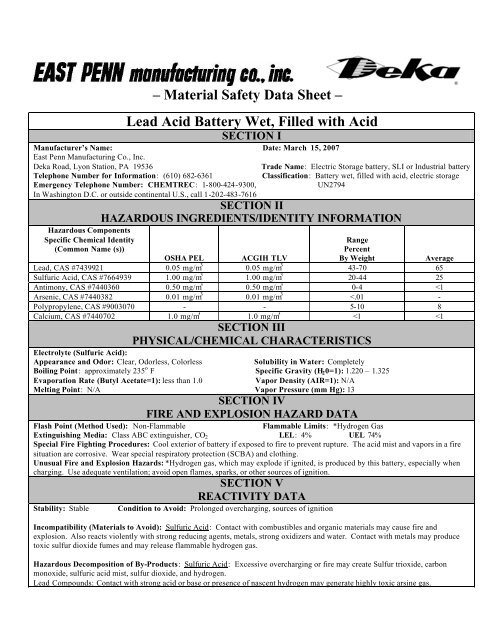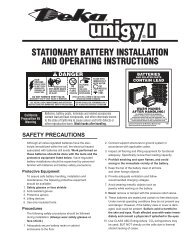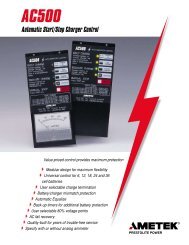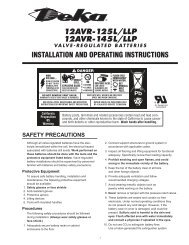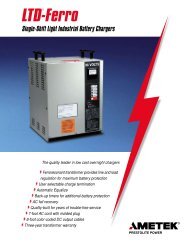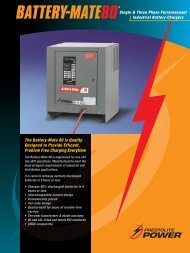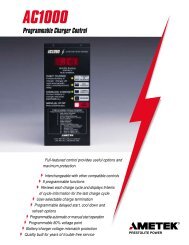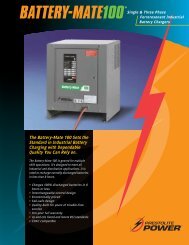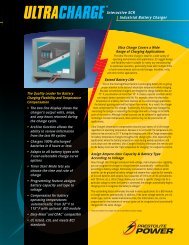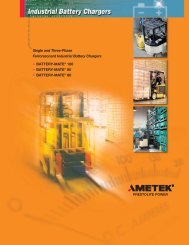Battery Wet, Filled with Acid.pdf - East Penn Canada
Battery Wet, Filled with Acid.pdf - East Penn Canada
Battery Wet, Filled with Acid.pdf - East Penn Canada
You also want an ePaper? Increase the reach of your titles
YUMPU automatically turns print PDFs into web optimized ePapers that Google loves.
– Material Safety Data Sheet –<br />
®<br />
Lead <strong>Acid</strong> <strong>Battery</strong> <strong>Wet</strong>, <strong>Filled</strong> <strong>with</strong> <strong>Acid</strong><br />
SECTION I<br />
Manufacturer’s Name: Date: March 15, 2007<br />
<strong>East</strong> <strong>Penn</strong> Manufacturing Co., Inc.<br />
Deka Road, Lyon Station, PA 19536<br />
Trade Name: Electric Storage battery, SLI or Industrial battery<br />
Telephone Number for Information: (610) 682-6361<br />
Classification: <strong>Battery</strong> wet, filled <strong>with</strong> acid, electric storage<br />
Emergency Telephone Number: CHEMTREC: 1-800-424-9300,<br />
UN2794<br />
In Washington D.C. or outside continental U.S., call 1-202-483-7616<br />
SECTION II<br />
HAZARDOUS INGREDIENTS/IDENTITY INFORMATION<br />
Hazardous Components<br />
Specific Chemical Identity<br />
(Common Name (s))<br />
OSHA PEL<br />
ACGIH TLV<br />
Range<br />
Percent<br />
By Weight<br />
Lead, CAS #7439921 0.05 mg/m 3 0.05 mg/m 3 43-70 65<br />
Sulfuric <strong>Acid</strong>, CAS #7664939 1.00 mg/m 3 1.00 mg/m 3 20-44 25<br />
Antimony, CAS #7440360 0.50 mg/m 3 0.50 mg/m 3 0-4
MSDS: <strong>Battery</strong> <strong>Wet</strong>, <strong>Filled</strong> <strong>with</strong> <strong>Acid</strong>; Page 2 of 3<br />
SECTION VI<br />
HEALTH HAZARD DATA<br />
Route(s) of Entry: Not Applicable under normal use. (Inhalation, skin contact, and ingestion)<br />
Health Hazards (Acute and Chronic): Do not open battery, avoid contact <strong>with</strong> internal components. Internal components are Oxide<br />
lead and electrolyte. Short term exposure: Sulfuric acid may cause irritation of eyes, nose, and throat. Prolonged contact may cause<br />
severe burns. Long term exposure: Repeated contact causes irritation and skin burns. Repeated exposure to mist may cause erosion of<br />
teeth, chronic eye irritation and/or chronic inflammation of the nose, throat, and bronchial tubes.<br />
TARGET ORGAN: (Electrolyte) respiratory system, eyes, skin, and teeth<br />
Carcinogenicity:<br />
Sulfuric <strong>Acid</strong>: The International Agency for Research on Cancer (IARC) has classified “strong inorganic acid mist containing<br />
sulfuric acid” as a Category 1 carcinogen, a substance that is carcinogenic to humans. This classification does not apply to liquid<br />
forms of sulfuric acid contained <strong>with</strong>in a battery. Inorganic acid mist (sulfuric acid mist) is not generated under normal use of this<br />
product. Misuse of the product such as overcharging, may result in the generation of sulfuric acid mist.<br />
Lead Compounds: Lead is listed as a 2B carcinogen, likely in animals at extreme doses. Proof of carcinogenicity in humans is<br />
lacking at present.<br />
Arsenic: Listed by National Toxicology Program (NTP), IARC, OSHA and NIOSH as a carcinogen only after prolonged exposure at<br />
high levels.<br />
Signs and Symptoms of Exposure: <strong>Acid</strong> contact may cause irritation of eyes, nose and throat. Breathing of mist may produce<br />
respiratory difficulty. Contact <strong>with</strong> eyes and skin causes irritation and skin burns. Sulfuric acid is a CORROSIVE chemical.<br />
Medical Conditions Generally Aggravated by Exposure: Sulfuric <strong>Acid</strong> Mist exposure may aggravate medical conditions such as,<br />
pulmonary edema, bronchitis, emphysema, dental erosion, and tracheobronchitis. Pregnant women and children must be protected<br />
from lead exposure.<br />
Emergency and First Aid Procedures: (Sulfuric <strong>Acid</strong>)<br />
1) Flush contacted area <strong>with</strong> large amounts of water for at least 15 minutes. Remove contaminated clothing and obtain<br />
medical attention if necessary. Eye wash and/or emergency shower should be readily available.<br />
2) If swallowed, give large volumes of water. DO NOT induce vomiting, obtain medical treatment.<br />
SECTION VII<br />
PRECAUTIONS FOR SAFE HANDLING AND USE<br />
Steps to be Taken in Case Material is Released or Spilled: SULFURIC ACID: Dilute spill cautiously <strong>with</strong> five to six volumes of<br />
water and gradually neutralize <strong>with</strong> sodium bicarbonate, soda ash or lime. When exposure level is not known, wear NIOSH approved<br />
positive pressure self-contained breathing apparatus. Reference North American Emergency Response Guidebook, #154.<br />
Waste Disposal Method: Lead-acid batteries are completely recyclable. For information on returning batteries to <strong>East</strong> <strong>Penn</strong> for<br />
recycling, contact your <strong>East</strong> <strong>Penn</strong> Representative. Dispose of any collected material in accordance <strong>with</strong> local, state or applicable<br />
federal regulations.<br />
Precautions to be Taken in Handling and Storing : Store away from reactive material as defined in Section V, Reactivity Data.<br />
Place cardboard between layers of stacked batteries to avoid damage and short circuit. Do not allow metallic materials to<br />
simultaneously contact both terminals.<br />
Other Precautions: Sodium bicarbonate, soda ash, sand, or lime should be kept in same general area for emergency use. Keep away<br />
from sources of ignition during charging see Section IV on generation of hydrogen gas. If battery case is broken, avoid direct contact<br />
<strong>with</strong> internal components.<br />
SECTION VIII<br />
CONTROL MEASURES<br />
Respiratory Protection (Specific Type): Respirator required when PEL is exceeded or employee witnesses respiratory irritation.<br />
(see Section VI, Health Hazard Data).<br />
Ventilation: Must be provided when charging in an enclosed area. (29CFR1910.178(g) and .305(j)(7)<br />
Mechanical (general): Acceptable at 1 to 4 air exchanges/hour or to maintain air concentrations below the PEL.<br />
Local Exhaust: Preferred<br />
Other: Local building/fire codes may require explosion proof fans and equipment<br />
Protective Gloves: <strong>Acid</strong> resistant<br />
Eye Protection: Preferred, safety glasses, goggles, face shield<br />
Other Protective Clothing or Equipment: <strong>Acid</strong> resistant aprons, boots, and protective clothing<br />
Work Hygienic Practices: Good Personal hygiene and work practices are mandatory.
For additional information concerning <strong>East</strong> <strong>Penn</strong> Manufacturing Co., Inc. products or questions concerning the content of this MSDS<br />
please contact your <strong>East</strong> <strong>Penn</strong> representative.<br />
This information is accurate to the best of <strong>East</strong> <strong>Penn</strong> Mfg. Co.’s knowledge or obtained from sources believed by <strong>East</strong> <strong>Penn</strong> to be<br />
accurate. Before using any product, read all warnings and directions on the label.


